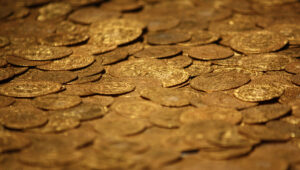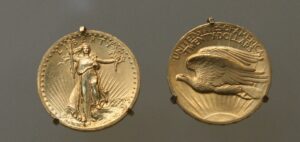When investing in precious metals for retirement, personal reasons, or to gain some value – you might be asking, “Are Precious Metals taxed?”
Well, you came to the right place.
In this article we are going to break down from A-to-Z everything you wanted to know about precious metal taxation, as well as topics like Value Retention, state laws, and more.
If you intend to read this entire article, plan to spend around 16 minutes to do so, or a bit less if you want to hop from chart to chart.
Investing in precious metals can be a strategic move for those looking to diversify their portfolio – like you!
So, let’s kick this article off by looking at six different precious metals.
Quick Disclaimer:
The content provided in this article is for informational purposes only and should not be considered financial or investment advice. Always consult with a qualified financial advisor before making any decisions regarding Precious Metals, Investing, or IRAs. Additionally, this article contains affiliate links, and I may earn a commission if you make a purchase through these links, at no additional cost to you.
Another question, I have been asked is, “What Gold IRA companies are the best” or “Which IRA companies are the most trusted?”.
If you’d like more information, below is a link to a comparison PDF by Augusta Precious Metals that could be useful. (It’s also free.)
Augusta Gold IRA Company Integrity Checklist
Value Retention of Precious Metals
So before we talk taxes, another valuable topic is whether precious metals maintain their value.
Why worry about taxes if they have no gains?
Precious metals like gold, silver, platinum, and palladium are known for their ability to retain value during economic downturns and periods of high inflation.
But, unlike cash investments, which can lose value due to inflation, precious metals often hold their value or even appreciate.
Here’s a quick look at the historical value retention of popular precious metals: (We’ll dive deeper in a second.)
| Metal | Historical Value Retention |
|---|---|
| Gold | High |
| Silver | Moderate |
| Platinum | High |
| Palladium | High |
Comparing Precious Metals
Each precious metal has its own set of characteristics, advantages, and challenges, making them suitable for different investment strategies.
Gold
Gold is the most well-known and widely invested precious metal. It is often seen as a safe haven during economic instability.
But, you may be surprised that it’s value is not driven by industrial demand or another civilization driver – if you will.
Gold’s high value and relatively low volatility make it a popular choice for long-term investments.
However, it is also subject to higher capital gains taxes when sold (MFEA).
Learn more about whether a precious metal IRA is a good idea.
| Metal | Relative Cost | Storage Space Required |
|---|---|---|
| Gold | High | Low |
| Silver | Low | High |

Silver
Silver is less expensive compared to gold, making it accessible for new investors.
However, its lower price can present storage challenges since more physical space is required to store the same value of silver compared to gold.
Silver’s price is more volatile, which can offer both opportunities and risks.
Platinum
Platinum is less commonly invested in compared to gold and silver but historically has had a price above that of gold.
Its price tends to be more stable across different market conditions, making it a good choice for those looking for a stable investment (Provident Metals).
For more on the benefits of investing in platinum, see what precious metals are IRA approved.
Palladium
Palladium is often used in automotive manufacturing and is similar to platinum in its industrial uses.
Its prices track closely with those of platinum, and it is often used by investors to add diversification to their portfolios (Provident Metals).
Learn more about the negatives of a precious metals IRA.
For more detailed information on the tax implications and other considerations, explore our articles on how to convert an IRA to precious metals and are precious metals considered assets.
| Metal | Use Case | Price Stability |
|---|---|---|
| Platinum | Automotive | High |
| Palladium | Automotive | High |
Lesser-Known Precious Metals
Copper
Copper is increasingly being considered by investors to hedge against currency devaluation.
While not traditionally viewed as a precious metal, its growing demand and limited supply make it an attractive option.
(Random fact I learned last week, Arizona has a ton of copper!)
Rhodium
Rhodium is another lesser-known metal, often used in industrial applications, particularly in automotive catalysts. It is rarer than gold and platinum, and its price can be highly volatile.
| Metal | Known For | Volatility |
|---|---|---|
| Copper | Industrial Use, Limited Supply | Moderate |
| Rhodium | Rare, Industrial Use | High |
Investing in these metals can provide a robust hedge against economic uncertainties.
For more information on the best ways to invest, see how much should you invest in precious metals?.

Another common question I get asked about sales tactics used by Gold IRA companies is about how silver is leveraged and mentioned.
If you want to learn more, below are two free PDFs by Augusta Precious Metals that break down how to check the integrity of an IRA provider as well as information on how Silver is used as a sales tactic.
Augusta Precious Metals Links:
Federal Taxation on Precious Metals
The IRS considers precious metals as “collectibles” for tax purposes.
This classification influences how your gains are taxed when you sell your precious metals.
Capital Gains Taxes
- Short-Term Gains: If you hold precious metals for less than one year, any profit from their sale is considered short-term capital gains. These gains are taxed as ordinary income, based on your marginal tax rate. (Hero Bullion)
- Long-Term Gains: If you hold precious metals for more than one year, the profits are considered long-term capital gains. These are subject to a maximum tax rate of 28%. (Hero Bullion)
| Holding Period | Tax Rate |
|---|---|
| Less than 1 year | Ordinary income tax rate |
| More than 1 year | Up to 28% |
State-Specific Taxation Rules
In addition to federal taxes, precious metal transactions may also be subject to state taxes.
These rules vary widely from state to state. Some states impose sales taxes on the purchase of precious metals, while others offer exemptions.
Sales Tax
While many states impose sales tax on precious metal purchases, others provide exemptions to encourage investment.
Examples of State Tax Policies:
- California: Exempts sales tax on purchases over $1,500.
- Texas: Exempts sales tax on all precious metal transactions.
- New York: Imposes sales tax unless the transaction exceeds $1,000.
For a more comprehensive list of state-specific tax rules, you can refer to our section on states with no sales tax on precious metals.
| State | Sales Tax | Exemption Threshold |
|---|---|---|
| California | Yes | Purchases over $1,500 |
| Texas | No | N/A |
| New York | Yes | Purchases over $1,000 |
Knowing how both federal and state tax rules apply to your precious metal investments can help you make more informed decisions.
For further reading, explore what are the negatives of a precious metals ira or how much should you invest in precious metals.

Tax Exemptions in Certain States
Navigating the world of precious metal investments can be complex, especially when considering the tax implications. Understanding which states offer tax exemptions on precious metals can help you make more informed decisions. Below, we cover states with no sales tax on precious metals and the various exemptions and thresholds that apply.
States with No Sales Tax on Precious Metals
Several states have chosen to exempt precious metals from sales tax, making them attractive locations for investors.
Here are some notable states with no sales tax on precious metals:
Texas: Texas does not tax the sale of gold, silver, or platinum bullion, including numismatic coins, as of 2013.
This exemption does not apply to precious metals in the form of jewelry or other adornment items.
Before 2013, investors who bought less than $1,000 worth of precious metals had to pay a 6.25% tax.
Texas also exempts capital gains tax, being among the states without a personal income tax (US Gold Bureau).
Ohio: As of July 6, 2021, Ohio no longer taxes the sale of gold, silver, platinum, and palladium.
However, some places may charge additional fees.
For example, in Columbus, the total sales tax is 7.5%.
| State | Sales Tax Rate | Exemption Status | Additional Notes |
|---|---|---|---|
| Texas | 6.25% | Exempt | Exemption does not apply to jewelry |
| Ohio | 7.5% | Exempt | Some local fees may apply |
Exemptions and Thresholds
Other states offer specific exemptions and thresholds that can benefit precious metal investors. Here are a few examples:
California: California has a 7.5% sales tax on bullion coins and bars.
However, there is a statewide exemption on precious metal purchases above $1,500.
Investors who buy more than an ounce of gold or silver from one dealer will not need to pay any tax.
Local counties and cities may impose a sales tax, but it is generally a small percentage (US Gold Bureau).
Florida: Florida’s state sales tax rate is 6%, with an additional 1–2% on average added by local municipalities.
Exemptions include purchases totaling over $500 and all US legal tender items like the Silver Eagle, regardless of the total purchase amount being under $500 (US Gold Bureau).
New York: All precious metal sales beyond $1,000 are tax-exempt in New York. Sales tax does not apply to purchases if the total amount exceeds $1,000 USD and certain premiums are not surpassed.
However, any bullion purchased exempt under the new provision of law but later converted to self-use would be subject to sales or use tax.
| State | Sales Tax Rate | Exemption Threshold | Additional Notes |
|---|---|---|---|
| California | 7.5% | > $1,500 | Local sales tax may apply |
| Florida | 6% + 1-2% | > $500 | Exemption includes US legal tender items |
| New York | Varies | > $1,000 | Subject to sales/use tax if converted to self-use |
For more information on the tax implications of precious metal IRAs, check out our articles on is a precious metal ira a good idea? and what are the negatives of a precious metals ira?.

Capital Gains Tax on Precious Metals
When you invest in precious metals, understanding how capital gains tax works is essential.
This section provides information to navigate the intricacies of short-term and long-term gains, as well as tax rates and reporting requirements.
Short-Term vs. Long-Term Gains
The holding period of your precious metals investment determines whether your gains are considered short-term or long-term.
- Short-Term Gains: These apply to investments held for less than one year. The tax rate for short-term gains is based on your ordinary marginal tax rate (Hero Bullion).
- Long-Term Gains: These apply to investments held for more than one year. The tax rate for long-term gains is capped at a maximum of 28%, but it is usually equal to your marginal tax rate.
Tax Rates and Reporting Requirements
The tax rates for your capital gains depend on how long you’ve held the precious metals and the type of metal. Here’s a breakdown:
| Holding Period | Tax Rate |
|---|---|
| Less than 1 year (Short-Term) | Your ordinary marginal tax rate |
| More than 1 year (Long-Term) | Up to 28% (MFEA) |
Since precious metals are classified as collectibles by the IRS, they are subjected to a higher capital gains tax rate compared to other investments like stocks or bonds.
Short-term gains are taxed at your ordinary income tax rate, while long-term gains are capped at a 28% rate.
When it comes to reporting, you must declare any gains from the sale of precious metals on your tax return.
This includes detailing the sale price, purchase price, and holding period. Proper documentation is crucial to accurately report these figures and comply with IRS regulations.
For further insights into the broader implications of investing in precious metals, including tax considerations and other factors, check out our articles on is a precious metal ira a good idea? and what are the negatives of a precious metals ira?.
For more detailed information, visit how to convert ira to precious metals and what are the irs rules for precious metals ira?.
Tax Considerations for Different Metals
When investing in precious metals through an Individual Retirement Account (IRA), it’s essential to understand how different metals are taxed.
Here, we’ll break down the tax rates for gold, silver, and platinum, as well as the tax treatment of precious metal jewelry.
Tax Rates for Gold, Silver, and Platinum
For tax purposes, the IRS classifies precious metals like gold and silver as collectibles.
This classification subjects these metals to higher capital gains taxes compared to other investments such as stocks or bonds.
Short-term gains (held for less than a year) are taxed at ordinary income rates, while long-term gains (held for more than a year) have a lower tax rate.
| Metal | Short-Term Capital Gains Tax | Long-Term Capital Gains Tax |
|---|---|---|
| Gold | 28% | 15% – 28% |
| Silver | 28% | 15% – 28% |
| Platinum | 28% | 15% – 28% |
Sources: MFEA
For those wondering, “are precious metals taxed?”, it’s crucial to note that short-term capital gains on precious metals are taxed at a higher rate of 28%.
Long-term gains, however, enjoy a reduced rate of 15% to 28%, depending on your income bracket (MFEA).
For more detailed information on the taxation of different metals, visit our article on what are the IRS rules for precious metals IRA?.
Tax Treatment of Precious Metal Jewelry
Precious metal jewelry, like bullion, is also considered a collectible by the IRS.
This means that if you sell jewelry made from gold, silver, or other precious metals for a profit, it is subject to the same maximum 28% capital gains tax rate as bullion.
| Item | Capital Gains Tax Rate |
|---|---|
| Gold Jewelry | Up to 28% |
| Silver Jewelry | Up to 28% |
| Platinum Jewelry | Up to 28% |
Sources: GoldSilver
The tax implications of selling precious metal jewelry can be significant.
It’s essential to report any profits on your income tax return to avoid penalties. For more insights on this topic, check out our article on how to sell gold IRA.
Whether you’re considering adding gold, silver, or platinum to your IRA, it’s important to be aware of the potential tax liabilities.
For additional guidance, you might find our article on how much gold do you need to retire? helpful.
Reporting Requirements for Dealers
When selling precious metals, certain reporting requirements apply.
For example, if you sell precious metals to a dealer, the dealer may be required to file Form 1099-B with the IRS.
This form reports the proceeds from the sale and is essential for tax reporting purposes.
| Sale Type | Reporting Form |
|---|---|
| Sales to Dealers | 1099-B |
| Cash Purchases | Varies by State |
The IRS mandates reporting transactions with precious metals, especially for cash purchases, trades with dealers, and trades with brokers.
Dealers must adhere to these reporting requirements to ensure compliance with federal tax laws.
For more detailed information on the tax implications of selling precious metals and other related topics, you can explore our articles on can you take possession of precious metals in an ira? and how safe is a precious metals ira?.
Special Considerations for Precious Metal Jewelry
When you think about precious metals, jewelry often comes to mind.
This section explores popular precious metals used in jewelry and their durability and maintenance, helping you make informed decisions for your investments.
Popular Precious Metals in Jewelry
Precious metals are favored for their beauty, rarity, and durability. Here are some popular choices for jewelry:
- Gold: Known for its timeless appeal, gold is a classic choice for jewelry. It comes in various shades, including yellow, white, and rose gold.
- Silver: Silver has been used in jewelry for thousands of years. Its lustrous appearance makes it a popular choice for both casual and formal wear. Silver is often alloyed with copper to increase its durability. While it may tarnish over time, proper care can keep it looking bright.
- Platinum: Platinum is hypoallergenic, lightweight, and resistant to tarnishing. It’s ideal for individuals with sensitive skin and requires minimal maintenance while retaining its bright appearance over time.
- Titanium: Known for its strength and light weight, titanium is highly durable and corrosion-resistant. It’s a popular choice for jewelry and other industries due to its ability to withstand harsh environments (Valentin Magro).
- Tungsten Carbide: Tungsten carbide is exceptionally durable and virtually scratch-resistant. It retains its polish longer than other metals, making it a popular choice for men’s jewelry items (Valentin Magro).
- Palladium: Part of the platinum group metals, palladium is lightweight, hypoallergenic, and resistant to tarnishing. It is often used in fine jewelry.
Durability and Maintenance of Metals
| Metal | Durability | Maintenance | Special Features |
|---|---|---|---|
| Gold | High | Moderate | Available in various shades; timeless appeal |
| Silver | Moderate | High | Tarnishes over time; requires regular polishing |
| Platinum | Very High | Low | Hypoallergenic, retains brightness, minimal maintenance |
| Titanium | Very High | Low | Lightweight, corrosion-resistant, ideal for harsh environments |
| Tungsten Carbide | Extremely High | Very Low | Scratch-resistant, retains polish, popular for men’s jewelry |
| Palladium | High | Low | Lightweight, hypoallergenic, tarnish-resistant |
For more information on the tax implications of precious metal investments, visit our article on are precious metals taxed?.
If you’re considering investing in a precious metal IRA, you might find our articles on what are the benefits of a precious metals ira? and how much should you invest in precious metals? helpful.



